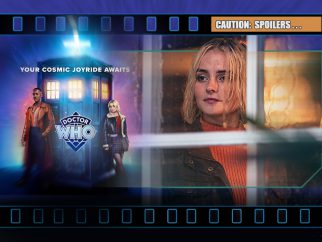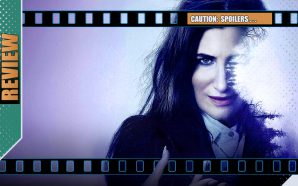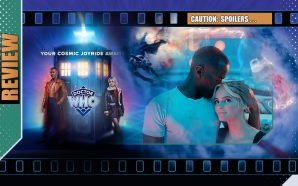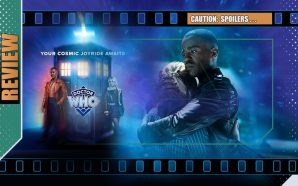The Doctor and Ruby arrive on a Welsh cliff-top where the Time Lord tells his companion some of the area’s rich history and somewhat dangerous future. But before they can enjoy their trip, the Doctor steps into what appears to be a ‘fairy-ring’ shrine and moments later Ruby realises she’s now very much alone.
The Tardis stands silent and she can’t gain entry and, if that is not strange enough, there’s a distant figure that keeps gesturing towards Ruby. Despite Ruby’s movements towards and away from her, the strange figure resolutely remains exactly 73 yards away from Ruby at all times and if anyone else approaches her on Ruby’s behalf, they end up shunning Ruby herself.
Is there a link to a local legend, which the customers of the local pub suggest in hushed tones, or is this happening to Ruby for some other reason? There are no easy answers and as the days turn into weeks, month and longer…. Ruby tries to uncover the truth and a part she has yet to play in potentially global events… and without any help from the Doctor.
*spoilers*
For a Time Lord who has a history of stepping around the fringes of history, the latest incarnation of the Doctor is getting remarkably careless. Last week it was a deadly mine, this week’s it’s a potentially tragic magic circle.
If the remit of Doctor Who‘s latest season is to demonstrate to both Disney and a wider audience the sheer scope of what the legacy series can offer (in both tone and subject-matter), then it’s likely the first four episodes of this new run have delivered it in spades. Yes, there’s a good chance that some of the broader entries haven’t been to certain fans’ likings while some have excelled (and the difference will likely conform to whatever individual tastes you have and prefer),,, but that’s the beauty and the precarious nature of a concept that can be so many things to so many people and yet needs some sort of core, whatever that is to each person.
Showrunner and episode-scripter Russell T Davies has suggested that this is one of his best episodes and while I’d pick a firm handful ahead of it, there’s no denying that it shirks any kind of easy template, which can be refreshing. The best thing to say about 73 Yards is that its somewhat uneven nature means that it’s far harder to pigeon-hole whether it’s exactly to your taste or not. There’s a very distinct horror vibe throughout. In the beginning it is magical and gothic but it steadily becomes more a tale about the nature of enforced isolation, both as a weapon and as a failsafe. I suspect that it’s the kind of episode that whether you ultimately come away loving it or not, it is one that will hold your attention throughout as you try to work out what’s going on, if not entirely all the ‘hows’ and ‘whys’ of it all..
In the war between the land and the sea, there’s certainly a haul of red herrings and Davies has some fun in cranking up the initial tensions before presenting a stereotype-subversion punchline ahead of the episode’s second half. (Though I can’t have been the only one who thinks both the early/later aspects of the story might have worked better as separate stories).
Modern Doctor Who has a pragmatic production pivot that allows more than one episode to be in production at the same time – having one episode being ‘Doctor-Lite’, focusing on the companion or companion-lite, with a focus on the Doctor. As Ncuti Gatwa had to juggle finishing his commitment to the Sex Education series, 73 Yards becomes a requisite showcase for Gibson who rises to the challenge and shoulders the story, with Gatwa confined to one book-ending set of scenes and like the well-regarded Tennant-era Turn Left, we get to see how the absence of the Time Lord pushes a companion into a more pro-active stance. Perhaps the make-up department doesn’t convince us of the passage of time (for twenty years, Ruby looks strikingly young and then ages dramatically in her ‘final’ years).
It’s hard to truly evaluate Aneurin Barnard as the charismatic political extremist Roger ap Gwillam who is key to some of the tale but appearing only in the last half of the episode and is almost a deus ex machina (crucial or not) by the time we’re done. Even as things conclude we don’t really know the kind of monster he is – human or something less/more – and he might have worked better as a slow-burn adversary rather than merely giving us the bullet-list of smarm without showing why he appeals to so many. (Gwilliam’s connection to one of his young female campaigner underlings, Marti, hints at some sort of off-camera abuse, but it’s never really explored). Even the modern political parallels of ‘personality-over-policy’ aside, his real danger to social order and nuclear imbalance is kept as abstract as needed as the third-rail aspect of the story or maybe it’s just that, with the timeline realigned at episode’s end (but arguably, not avoided?) there’s more to find out and specify later in the season?
Dame Siân Phillips amkes the most of a few scenes, Kate Lethbridge-Stewart makes a more interesting appearance (talking about how UNIT helps those ex-companions to readjust for their place in the world, but then unable and eventually unwilling to help Ruby) as does Anita Dobson’s Mrs. Flood, there’s no real character development there. Actor Susan Twist turns up again (this time as a cliff-side hiker) and even Ruby gets the deja-vu feeling with which the audience is already aware. Despite some thinking that this might be the time to reveal more, there’s still no real clue to her rhyme-or-reason or Davies’ intent with her recurring presence.
Ultimately this is a variation on The Man who Haunted Himself, Trek‘s Inner Light, The Dead Zone film and with more than a touch of M R James and even An American Werewolf in London. Not all aspects work to form a complete whole, but enough do so in the moment, helped by Gibson. The third act’s use (rather than explanation) of the 73 Yards motif is satisfying, though much of the mechanics beyond that remain annoying out of reach or focus. By the end, there are few complete answers. After spinning a compelling, atmospheric tale, Davies painst himself into a narrative corner and can’t quite stick the landing, fudging some of the specifics in service to tone and consequently the obvious contradictions, handwavery details and all-out plot holes threaten to derail proceedings. (Seriously, despite all the sacrifices, or even because of them, how is the more scary future actively changed and what actually caused a different timeline – these things are actually important?).
Yes, it’s too many nice ideas thrown together and too few explanations to tie them together thatstop this from being an all-time great, but tonally it’s all very effective and worthwhile in the moment and, like Turn Left, ambitious and diverting.

- Story8
- Acting9
- Direction9
- Production Design / VFX8











